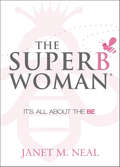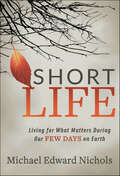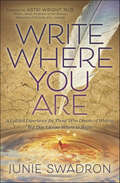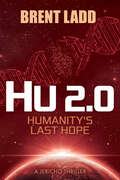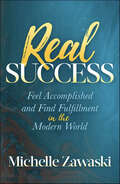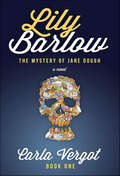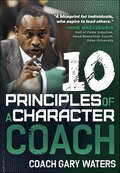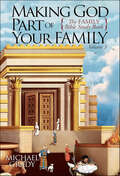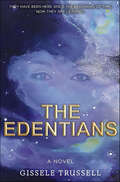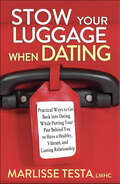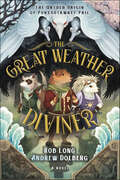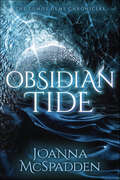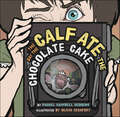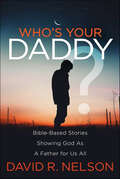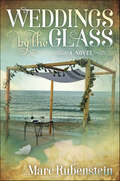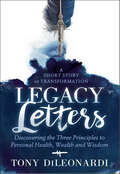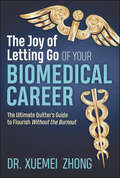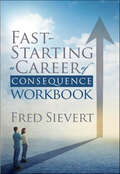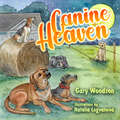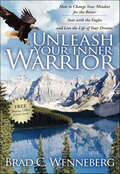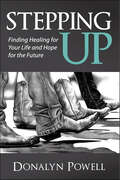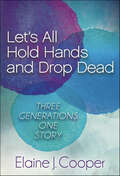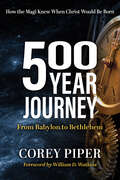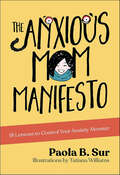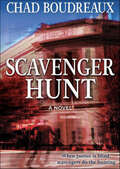- Table View
- List View
The Superbwoman: It’s All About the BE
by Janet M. NealThe Superbwoman is a parable about a stressed out single working mother who sees a media icon who seems to have it all, and goes on a quest to figure out how she does it. It contains stories of the women she meets along her way and the lessons she learns from them. Any woman who finds herself trying to do it all, do it by herself, and do it perfectly will relate to this tale told from the perspective of a burned-out Superwoman who knows there has to be a better way. The answers are revealed in a simple, easy to follow narrative that will bring relief, smiles and more joy to the reader.
Short Life: Living for What Matters During our Few Days on Earth
by Michael Edward NicholsThe theme of Short Life is the brevity of life developed through several transparent stories from the life of Michael Edward Nichols. Most people want to live a meaningful life, but many end up living mundane, routine lives that seem to have no purpose. Many want to live well but lack the motivation to get started. Short Life aims to awaken every person to realize their time on earth is short and give practical tips on how to redeem the time the Lord has given those on earth. Michael Edward Nichols discovered the truth that focusing on one’s own death can teach them how to live. Since, the quality of his life has been dramatically impacted by the realization that life is very short. Michael’s goal is to be a catalyst for transformation in other people’s lives from inside out. Part one of Short Life focuses on inner thoughts and attitudes. Part two concentrates more on outward behavior and relationships. The counter-cultural premise of Short Life challenges readers to actually think about his or her death as much as possible. Surprisingly, rather than causing one to become morbid or depressed, thinking about one’s own death actually unleashes the power to live an authentic, full life.
Write Where You Are: A Guided Experience for Those Who Dream of Writing but Don’t Know Where to Begin
by Junie SwadronA personal treasure to anyone seeking self-knowledge, inner peace, and direct access to their authentic self-expression, Write Where You Are is a portal into discovering oneself through the art of writing. Write Where You Are is for those who know they want to write but need help knowing where to begin. Junie Swadron's newest writing resource offers foolproof—and often hilarious—solutions to help even the greatest skeptics start writing. Her book recognizes common fears and perfectionist tendencies, guides the reader through these pitfalls, and into the potential stories hiding within each of us. Sharing her own stories and life experiences, Junie Swadron’s approach instills confidence and creative freedom in reluctant writers.Swadron knows how powerful it can be when a writer finds their voice on the page—and shares that voice in the world! Write Where You Are encourages journaling as a way for writers to discover their preferred narrative style and genre—from poetry and prose to plays and essays to blogs, songwriting, and speechwriting.With fun and thought-provoking writing prompts and exercises, Junie Swadron transforms reluctant writers into confident authors! Write Where You Are is an essential resource for beginning writers who need help to begin their writing journey.
Hu 2.0: Humanity's Last Hope
by Brent LaddThe future is not all automation and robots. As mankind advances, he also falters…Can a man born of science find his humanity in a polarized dystopian society bent on destruction and greed? In Brent Ladd’s newest release, Hu 2.0 tells a story of mankind’s possible future—one that is ripped apart when the evolution of the species divides into two categories: Human 1.0 (original) and 2.0 (new). The rift sparks a war that leaves the planet decimated, with original humans on the brink of extinction. A man made from science and raised by AI, Jericho must find and fight for his place in this new world if he hopes to save it.
Real Success: Feel Accomplished and Find Fulfillment in the Modern World
by Michelle ZawaskiWhen hard work and accomplishments don’t lead to a sense of success, it may be time to redefine success. In today’s world, it seems like everyone is always on the go, but checking boxes and getting things done does not always lead to personal satisfaction. Real Success is a guide for those serious about finally finding their real success. Entrepreneur and coach Michelle Zawaski tackles the question of why people can’t seem to find contentment and what they need to do to breathe new life into the every day. She guides readers to defining real success for themselves, finding fulfilment, energizing themselves, rekindling their passions, and accomplishing more without adding anything to their already hectic schedules. For those who are ready to stop doing everything they are supposed to with no results, Real Success reveals a better reality for anyone ready to truly live their life.
Lily Barlow: The Mystery of Jane Dough
by Carla VergotLily Barlow has one goal in life: to get out of her hometown. But after her father’s heart attack, Lily returns home from college to get the family business running, while simultaneously searching for the identity of a murder victim.After pausing her plans and returning to sleepy Marshall, Virginia, 21-year-old Lily Barlow is determined to keep this visit short and sweet. Rather than temporarily moving back home, Lily opts to rent a room from Miss Delphine Walker, a senior who grows flowers and mutters about the murderous intentions of the human heart.Lily’s return prompts Jack Turner, her best friend since kindergarten, to ask if they can be more, just as Lily begins investigating the identity of an unidentified murder victim. Fancying herself a southern-fried version of Stephanie Plum, Lily dodges Jack’s romantic advances as she dives into the mystery with exuberance and good intentions.Told in a sometimes sweet, sometimes snarky southern accent, Lily Barlow Book One: the Mystery of Jane Dough delivers romance, comedy and mystery in a joyride of contemporary fiction. Readers will laugh out loud at this fast-paced tale complete with relatable characters, quaint small-town setting and loads of southern charm.
Ten Principles of a Character Coach
by Coach Gary WatersTen Principles of a Character Coach provides clear experienced-based advice on how to be a character coach.Within Ten Principles of a Character Coach, Coach Gary Waters defines a character coach as someone who lives a life with integrity, honesty and moral values. He speaks specifically on how the sport of basketball has been riddled with scandals in recent years on the high school and college levels; and how the governing authorities are committed to repairing the reputation of college basketball. Ten Principles of a Character Coach addresses many of the issues that young men and women are experiencing in the athletic arena today. Coach Waters believes character and values need to be a high priority in those individuals tasked with guiding young people, as well as themselves. Furthermore, Coach Waters is convinced that following the principles within Ten Principles of a Character Coach will benefit anyone in developing their character.
Making God Part of Your Family: The Family Bible Study Book Volume 3
by Michael GradyMaking God Part of Your Family Volume 3 strives to bring God’s plan to life for individuals and their families as He chose to reveal these truths through the stories in the Old Testament.Most would agree that the Old Testament stories can be difficult to relate to and understand. Veteran Bible teacher Michael Grady retells the Old Testament stories in concise, thought-provoking doses that are easy to understand and intended to stimulate family discussions. He demonstrates that the Old Testament stories are much more than just a history of the Israelites (God’s chosen family); they are parables detailing God’s guide to living and his eternal plan for redemption and salvation for all who choose to believe. The stories in Making God Part of Your Family Volume 3 provide a unique combination—they are both simple enough for children to understand and deep enough for parents to grow in the knowledge and wisdom of God’s Word. This vibrant, yet carefully researched volume brings families closer together and helps them clearly establish their identity as children of God and brothers and sisters of Jesus.
The Edentians: A Novel
by Gissele TrussellWith celestial war on the horizon, and the failure of Earth Project 606 (the rehabilitation of fallen angels and their offspring), the Edentian Council is set to abandon humanity. Only Danielle Peschard, the sole Edentian representative on Earth, can appeal to the council on Earth’s behalf. But can one person truly change the fate of the entire world?A renowned archeologist working for the MET, Danielle Peschard is familiar with the erudite and complex players in New York’s elite circles. She is also keenly aware that things are not as they seem. Earth’s inhabitants use their free will with little concern for cosmic consequences, but Danielle knows the truth—that the Edentian Council, a group of cosmic beings dispassionately monitoring the evolution of the human race, has concluded mankind’s gift of free will to be a mistake that must be corrected.As the only Edentian to be incarnated in a human body, Danielle must reestablish communication with Edentia and disrupt the nefarious plans of those set on enslaving humanity. But just as she attempts to take action, her interstellar communications cut out and she is brutally assaulted. This attack reignites an eternal conflict between the forces operating on Earth, and the only way to prevent Earth’s destruction by cosmic abandonment is for Danielle to present the best humanity has to offer to the Edentian Council as proof of Earth Project 606’s success. In a frantic race across the globe, Danielle must match wits in mortal combat with The Group: a nefarious consortium of planetary tycoons determined to implement a sinister plot—and possibly obliterate the human race.The Edentians extrapolates conflicts from Earth’s present condition and compels readers to wrestle with the origin and purpose of human existence. From Paris and the Vatican to the Egyptian pyramids and the Teotihuacan ruins, Gissele Trussell takes readers on a thrilling speculative journey that untangles webs of corporate greed, political treachery and terrorism against a cosmic, multi-layer plot that examines and challenges modern beliefs about religion and reality.
Stow Your Luggage When Dating: Practical Ways to Get Back into Dating While Putting Your Past Behind You to Have a Healthy, Vibrant, and Lasting Relationship
by Marlisse TestaDating is drastically different now than it used to be. Years ago, divorce was considered socially taboo, and people married for life; today, however, having multiple marriages and committed relationships has become the norm, making it essential for those who are single (and seeking relationships) to shift in their search to find the right partner.A relatable reference for each stage of the dating process, Stow Your Luggage When Dating directly speaks to the reader’s need for healing from previous relationships and the importance of self-worth before getting back into the dating game. Marlisse Testa, L.M.H.C., offers valuable tools and strategies for daters of any age or experience level. She outlines all the information necessary for those entering the dating pool, preparing for a date, connecting with others, and selecting a partner for life.
The Great Weather Diviner: The Untold Origin of Punxsutawney Phil
by Rob LongTo become a legend, a young groundhog must unravel a shocking secret to stop a weather catastrophe.When a mysterious flood strikes the small mining town of Punxsutawney, Junior the groundhog embarks on a journey to uncover why nature itself has turned on his people. As Junior and his new friends adventure through the fantastical world of Erda, he realizes that there's more to his family and their weather-controlling powers than he ever imagined.Junior desperately searches for legendary animal Guardians who have always offered help in times of need, but the evil raven overlord Callidus fights to protect a secret that could change Erda forever.Guided by the wisdom of Jill, an ingenious hedgehog, Junior's voyage becomes more than a quest for answers. It's a journey of self-discovery, responsibility, and redemption. As the story unfolds, Junior faces hard truths about climate change and the environment, the weight of legacy, and the magic of storytelling. Can he step out of his father's shadow to save the world?For those who reveled in the action of Redwall by Brian Jacques or the legend of the Guardians of Ga'Hoole by Kathyn Lasky, The Great Weather Diviner is a fractured fairy tale with a rich tapestry of fantasy, adventure, and enlightenment. This middle grade adventure is also beloved by older readers looking for an exciting story with a message.Will Junior harness the power of his past to shape Erda's future? Find out in this epic fantasy adventure for a new generation of middle-grade dreamers! Get your copy of The Great Weather Diviner now!
Obsidian Tide
by JoAnna McSpaddenCan two unlikely heroes break free from societal expectations and find the inner strength to save their kingdom in Obsidian Tide?Set in the splendor of the Victorian Age and mixed with the intrigue of a classic fantasy quest – Obsidian Tide chronicles the epic quest of Princess Katerina, Liam – the Akarian Emperor’s outcast nephew, and Anthony – Liam’s brother and the Emperor’s chosen heir to retrieve a magical relic. The Healing Stone is one of four long lost magical stones. It is known to contain the powers needed to cure any disease and when the threat of a terrible disease, known as The Obsidian Streaks, hits too close to home, the Healing Stone soon becomes Akaria’s only hope. Readers will follow the daring trio of the Akarian Empire royalty as they’re forced into societal roles that go against what they desire. The trio embarks on a harrowing quest to find the dragon-protected Healing Stone that promises to save many lives from the grip of the Obsidian Streaks. Along their journey – through triumphs, perils, and major setbacks – the trio must navigate the world, learning more about themselves all the while being the last line of hope to preserve the Akarian Empire’s storied legacy. The journey forces the characters to set aside who they were always told to be, in order to embrace who they truly are.
The Day the Calf Ate the Chocolate Cake
by Rachel Campbell DeddensThe Day the Calf Ate the Chocolate Cake follows the adventure of a young girl on the family farm. It takes place in the past, when life was simple and people lived on small farms that were part of a smaller community. It is a story with some words no longer or rarely part of today’s vocabulary, such as cattle guard, handkerchief, and saucer. It is a lesson on early modes of transportation, such as using wagons or one’s own feet. It takes place during a time when children had chores and learned responsibility. It is a story about a place that really existed, and it is a story of how a young girl saves the family farm.
Who's Your Daddy?: Bible-Based Stories Showing God As A Father for Us All
by David R. NelsonWho’s Your Daddy? Bible-Based Stories for Modern Families: Season 1 is a collection of biblically-based stories that explores how characters in Scripture felt as they lived through their experiences.The art of storytelling and writing, which is integral to the development of the Christian church, must be encouraged. Jesus often used stories to illustrate or make a point and a well-crafted, Bible-based story has the capacity to capture the imagination, inspire, comfort, and encourage. Who’s Your Daddy? Bible-Based Stories for Modern Families: Season 1 provides an opportunity for all to meet the abiding need to ‘hear and tell’ and to have a story to live by.Season 1 begins with the nativity story before continuing to depict scenes from the lives of young biblical characters from both the Old and New Testaments that explores a variety of issues such as teen identity, self-acceptance, mentorship, healing, forgiveness, and commitment. It goes on to a section on fathers, which reflects on some of the issues they face, such as self-conflict, the grieving process, self-sacrifice, and surrender to God’s divine will, before culminating in the Easter story. In Who’s Your Daddy? Bible-Based Stories for Modern Families: Season 1, David R. Nelson has created a delightful read for both teens and families with stories that can also be utilized in church and school programs to supplement their existing teaching.
Weddings By The Glass
by Marc RubensteinHillie Gordon is a model modern woman, well-educated, successful, talented. The man of her dreams, Jacob Jaworski, purposes to her, setting of a whirlwind of planning, travel, and preparation for the "Big Day." Searching for the "perfect" wedding officiant, Hillie meets Rabbi Sam Glassman, creating a heroic partnership to bring to fruition the ideal wedding ceremony she had promised her mother.Like all brides, Hillie must overcome many hurdles on her journey "down the aisle." Struggling to integrate everything needed for an Interfaith wedding, she juggles family expectations, relying on old friends and finding new friends along the way. Unexpected surprises await Hillie as she barrels through what all brides see reflected in their experience: a delightful mess of love and obligations. Hillie relies on her best friend Amanda for guidance, and also discovers an amazing ally in Christina, her wedding coordinator at a beautiful winery in Temecula, California.Beautiful settings, inspired spirituality, humor, and wonderful characters will keep readers inspired and wanting more. As Hillie is often fond of saying: "Tell me something good!"
Legacy Letters: – A Novel – A Short Story of Transformation
by Tony DiLeonardiProfessional money manager, Jim Peters, a committed husband and father of three, is experiencing a critical crisis of confidence, and his typical optimism and resiliency is crumbling. He believes his family's well-being and his dreams are in jeopardy as he is being pushed out of his job by unscrupulous competition and younger, tech-savvy workers.On the brink of making costly decisions, Jim is sensing that he's losing his grip on everything that is important to him, including his legacy. He is battered by the institutional influences over his life. Jim, however, is about to discover an old way of living that will create a new way of thinking and it will come from a most unusual place.Through a series of recently discovered ancient letters, Jim travels through time. Along his journey, he is given the gifts of perspective, new life, and a renewed spirit. He learns the time-tested secrets to create good health, true wealth, and genuine wisdom, re-takes control of his life, and helps lead and transform the lives of his family, friends, colleagues, and community. Legacy Letters is a modern parable of one man's choices and teaches readers the acquired virtues that create a new life for him.
The Joy of Letting Go of Your Biomedical Career: The Ultimate Quitter’s Guide to Flourish Without the Burnout
by Xuemei ZhongA complete toolkit for making a hard decision easier, The Joy of Letting Go of Your Biomedical Career is the resource needed to put the joy back in life.In The Joy of Letting Go of Your Biomedical Career, Dr. Xuemei Zhong tells of her own struggle leaving the angst that came with her job at a top medical school; and how that episode in her life inspired her to found HOE Holistic Wellness LLC. Dr. Zhong discusses how to find fulfillment in work and life and lays out her groundbreaking seven-step decision-making process. Within The Joy of Letting Go of Your Biomedical Career, she helps professionals who want to reconnect to their true purpose by developing a plan to a flourishing career without losing themselves. Throughout its pages, Dr. Zhong explains to those searching for this career path how to:Save lives without sacrificing their health and familyNot waste their medical training even if they leave for another careerEarn as much as their current salary, if not moreCheck if they made the right decision with one simple testCreate a plan to move forward regret-free
Fast Starting a Career of Consequence: Workbook
by Fred SievertFast-Starting a Career of Consequence—Workbook is the companion workbook of Fast-Starting a Career of Consequence. It is an invaluable current and future resource for readers of Fast-Starting a Career of Consequence as they proceed to implement the fast-start tips and strategies discussed in the fifteen chapters of the book.The key points, action steps, and cautions in Fast-Starting a Career of Consequence—Workbook provide readers with a means to track progress as they enter or re-enter the workforce, with the objective of fast-starting a career of consequence. Fast-Starting a Career of Consequence—Workbook combines five biblical principles and ten practical, proven tips for individuals entering or reentering the workforce. The key points, action steps, and cautions in each chapter provides readers with a tool to track their progress toward early career success. Each chapter ends with a sample prayer that provides a way for readers to approach God for guidance in implementing and realizing the value of the advice contained throughout the workbook. The succinct summaries and checklists of action items in Fast-Starting a Career of Consequence—Workbook make it ideal for subsequent review of the key points without requiring a time-consuming rereading of the original book. Also, the workbook provides numerous coping techniques for balancing faith, family, and career while working in an increasingly competitive and demanding workplace.
Canine Heaven
by Gary WoodsonCanine Heaven is an endearing story of hope fulfilled in the lives of Quito and Ben, two canine friends for life.Canine Heaven is based on Gary Woodson’s real-life experiences with two of his family’s nine dogs. It is told from the dogs’ perspective and is engaging and sweet and resonates with young readers. Canine Heaven is designed to help children identify with the life and longing of every dog to unite with a canine-loving family where they may live out their life happy and healthy. In Canine Heaven, two dogs – Quito and Ben – search for a new home after having been abandoned, again. Recognizing the poverty and frailty of Ben, Quito sets out on his own to find a dog-loving family who will adopt the two of them. Through a series of trials and disappointments, Quito meets a man in a cowboy hat whom he hopes will offer him and Ben a permanent home. When the man informs Quito that he already has six dogs and could not adopt him, Quito’s hopes are dashed. Why couldn’t he and Ben be as lucky as the other six dogs? Or, would an unexpected guest change this cowboy’s mind the following morning? Themes of friendship, perseverance, compassion and sacrifice abound as Canine Heaven celebrates the experience of coming home.
Unleash Your Inner Warrior: How to Change Your Mindset for the Better, Soar with the Eagles, and Live the Life of Your Dreams
by Brad C. WennebergBrad Wenneberg wasn't always a 6th degree Black Belt. Nor was he always a father, a husband, a teacher, a mentor, a community leader and a man of conviction. He was, however, an alcoholic spinning out of control—so much so that he found himself on the wrong end of a gun one warm spring evening. It wasn't until Wenneberg committed to a complete personal transformation that he was able to begin his journey toward personal, emotional, financial, and spiritual freedom. In Unleash Your Inner Warrior, Wenneberg challenges us to transform our own lives for the better; to commit to basic success principles that allow us to create a life of happiness, wealth, and abundance as well as leaving a lasting and meaningful legacy. "Unleashing my inner warrior was a challenge to me in every way—a challenge to the way I do business, to my habits, to my self-esteem, and to my comfort zones. It is a challenge to learn what I need to know, not what I want to know," writes Wenneberg.
Stepping Up: Finding Healing for Your Life and Hope for the Future
by Donalyn PowellMost cries of pain from teenagers are silent, and too often we only discover the true depth of their pain after suicide or other self-destructive behavior. In Stepping Up, teens speak openly about their struggles with suicide, depression, sex, drug addiction, pregnancy, abuse, bullying, and self-destructive behavior through their personal letters to author Donalyn Powell, a long-time youth and suicide-prevention advocate. To each letter, Powell offers personal and practical hope: even in the darkest situations, the pain will not last, and we are never alone. God has a purpose for each of us that we alone can fulfill, and it is God’s life in us that provides our reason for living, healing for our lives, and hope for the future.
Let's All Hold Hands and Drop Dead: Three Generations One Story
by Elaine J. CooperQuietly step into a group therapy meeting and listen to the members and the celebrated group therapist struggle to connect in true relationship. Witness the Russian Revolution and famine through the eyes of a boy. Watch two Jewish children in East L.A. in the 50's, trying to make sense of their world. Go deep into the Social Unconscious and discover how these adventures are not only connected to each other but to YOU as well.
500 Year Journey: How the Magi Knew When Christ Would be Born
by Corey Piper500-Year Journey examines historical and scriptural evidence to identify the date Christ was born, which wasn’t December 25th!For more than two-thousand years, Christians and skeptics have sought the truth of Jesus’ birth—with many looking in the wrong places. One group studied the stars and astrology for answers, to determine what the Magi might have seen, but that only created more questions. Others looked to mathematical calculations and tradition, but mistaken variables led them astray. Both of these approaches have contributed to the modern version of Christmas, but they have also obscured God’s truth.Corey Piper’s 500-Year Journeymakes the case that God revealed exactly when the Messiah would be born. The answer is in his Law, foreshadowed with biblical and historical events and confirmed by what the Magi saw. This resource will take readers from the exile in Babylon to the manger in Bethlehem, to a stunning encounter with God’s elaborate plan.
The Anxious Mom Manifesto: 18 Lessons to Control Your Anxiety Monster
by Paola B. SurThe Anxious Mom Manifesto: 18 Lessons to Control Your Anxiety Monster by Paola B. Sur, is an original, provocative, and honest take on motherhood, anxiety, and facing one’s own monsters.A memoir of personal stories, experiences, and tips from Sur’s journey as a mom living with anxiety, The Anxious Mom Manifesto offers encouragement, motivation, and guidance for mothers with anxiety. With methods to control and redirect emotions and thoughts efficiently, The Anxious Mom Manifesto encourages mothers to use their imagination and creativity to make anxiety work in their favor.Embracing anxiety to become more present in children’s lives is one of the main lessons Sur teaches, which fosters self-empowerment to improve the motherhood experience. A hopeful handbook for mothers of all kinds, The Anxious Mom Manifesto features real and relatable experiences as opportunities to practice and learn and invites mothers to change the stigmas related to motherhood and mental health.
Scavenger Hunt: A Novel
by Chad BoudreauxWHEN JUSTICE IS BLIND, SCAVENGERS DO THE HUNTINGBlake Hudson just wants to serve his country well as a lawyer for the United States Justice Department—but when an unknown threat begins plotting his downfall, he must find who is setting him up before it costs him his life.Scavenger Hunt is a suspense novel chronicling the plight of Blake Hudson, a Justice Department lawyer assigned to a clandestine counterterrorist group created to bypass onerous legal requirements. After the group mysteriously disbands, Hudson becomes the scapegoat and is transformed from hunter to hunted. As he searches for answers and attempts to piece the puzzle together, people are following him, trying to kill him. Written for fans of fast-paced thrillers, dry humor, political gamesmanship, and Clue-like twists and turns, Scavenger Hunt carves out a distinct niche best described as a hybrid of the Robert Ludlum classics and works by Brad Meltzer. Blake Hudson's story addresses issues that have shaped recent elections and continue to frustrate interest groups and government leaders, while featuring the inner workings of the U.S. Department of Justice Building—arguably the most important and misunderstood agency in the federal government. Author Chad Boudreaux's unique voice and page-turning storytelling packs a plot-driven punch that readers won't be able to put down.
